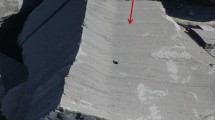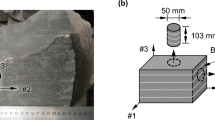Abstract
Fracking is widely applied to enhance shale gas mining, and insight into the fracture behaviors of shale rocks is important. To characterize the fracture properties of Lower Silurian Longmaxi shale, a chevron-notched deep beam specimen, which inherits the advantages of notched deep beam and chevron-notched specimens, is introduced, and several three-point bend tests were conducted on the Longmaxi shale specimens in three principal fracture orientations: the divider, short-transverse, and arrester orientations; the anisotropy in the critical shape coefficient, fracture toughness and fracture energy were then examined and highlighted. The results demonstrate that the critical shape coefficient depends on the anisotropic elasticity of the investigated shale, and a maximum error in the calculated fracture toughness of 9.2% could occur if a critical shape coefficient for isotropic rock is adopted. For the tested shale, the mode I fracture toughness in the divider orientation is close to that in the arrester orientation, with both values being approximately 1.5 times that in the short-transverse orientation; in addition, a progressive decrease in fracture energy from the arrester orientation to the short-transverse orientation is apparent. The fracture surface morphology was observed by scanning electron microscopy, and obvious material deterioration was found near the fracture surfaces for the arrester and divider samples.













Similar content being viewed by others
References
Amadei B (1996) Importance of anisotropy when estimating and measuring in situ stresses in rock. Int J Rock Mech Mini Sci Geomech Abstr 33(3):293–325
Aminzadeh A, Fahimifar A, Nejati M (2019) On Brazilian disk test for mixed-mode I/II fracture toughness experiments of anisotropic rocks. Theoret Appl Fract Mech 102:222–238
ASTM (2009) Standard Test Method for Linear-Elastic Plane-Strain Fracture Toughness KIc of Metallic Materials Vol E399–12e3. ASTM International, West Conshohocken
Atkinson C, Smelser RE, Sanchez J (1982) Combined mode fracture via the cracked Brazilian disk test. Int J Fract 18(4):279–291
Awaji H, Sato S (1978) Combined mode fracture toughness measurement by the disk test. J Eng Mater Technol 100(2):175–182
Banks-Sills L, Wawrzynek PA, Carter B, Ingraffea AR, Hershkovitz I (2007) Methods for calculating stress intensity factors in anisotropic materials: Part II—Arbitrary geometry. Eng Fract Mech 74(8):1293–1307
Barker LM (1977) A simplified method for measuring plane strain fracture toughness. Eng Fract Mech 9(2):361–369
Bush AJ (1976) Experimentally determined stress-intensity factors for single-edge-crack round bars loaded in bending. Exp Mech 16(7):249–257
Chandler M, Meredith P, Crawford B (2013) Experimental determination of the fracture toughness and brittleness of the mancos shale. Utah Br J Psychiatry 184(6):110–117
Chandler MR, Meredith PG, Brantut N, Crawford BR (2016) Fracture toughness anisotropy in shale. J Geophys Res Solid Earth 121(3):1706–1729
Chandler MR et al (2018) Correlative optical and X-ray imaging of strain evolution during double-torsion fracture toughness measurements in shale. J Geophys Res Solid Earth 123(12):10517–10533
Chen M, Zhang GQ (2004) Laboratory measurement and interpretation of the fracture toughness of formation rocks at great depth. J Petrol Sci Eng 41(1):221–231
Chen J, Deng J, Yuan J, Yan W, Yu B, Tan Q (2015) Research on the determination of type I and II of shale formation fracture toughness. Chin J Rock Mech Eng 34(6):1101–1105
Chong KP, Kuruppu MD (1984) New specimen for fracture toughness determination for rock and other materials. Int J Fract 26(2):R59–R62
Dai F, Chen R, Xia K (2010) A semi-circular bend technique for determining dynamic fracture toughness. Exp Mech 50(6):783–791
Dai F, Wei MD, Xu NW, Ma Y, Yang DS (2014) Numerical assessment of the progressive rock fracture mechanism of cracked chevron notched Brazilian disc specimens. Rock Mech Rock Eng 48(2):463–479
Dou F, Wang JG, Zhang X, Wang H (2019) Effect of joint parameters on fracturing behavior of shale in notched three-point-bending test based on discrete element model. Eng Fract Mech 205:40–56
Forbes Inskip ND, Meredith PG, Chandler MR, Gudmundsson A (2018) Fracture properties of nash point shale as a function of orientation to bedding. J Geophys Res Solid Earth 123(10):8428–8444
Fowell RJ (1995) Suggested method for determining mode I fracture toughness using cracked chevron notched Brazilian disc (CCNBD) specimens. Int J Rock Mech Min Sci 32(1):57–64
Funatsu T, Shimizu N, Kuruppu M, Matsui K (2014) Evaluation of mode I fracture toughness assisted by the numerical determination of K-resistance. Rock Mech Rock Eng 48(1):143–157
Gao Y, Liu Z, Zeng Q, Wang T, Zhuang Z, Hwang K-C (2017) Theoretical and numerical prediction of crack path in the material with anisotropic fracture toughness. Eng Fract Mech 180:330–347
Guo J-C, Zhao Z-H, He S-G, Liang H, Liu Y-X (2015) A new method for shale brittleness evaluation. Environ Earth Sci 73(10):5855–5865
Hakala M, Kuula H, Hudson JA (2007) Estimating the transversely isotropic elastic intact rock properties for in situ stress measurement data reduction: a case study of the Olkiluoto mica gneiss, Finland. Int J Rock Mech Min Sci 44(1):14–46
Heng S, Yang CH, Guo YT, Wang CY, Wang L (2015) Influence of dedding planes on hydraulic fracture propagation in shale formations. Chin J Rock Mech Eng 34(2):228–237
Ji W, Song Y, Jiang Z, Meng M, Liu Q, Gao F (2017) Micron-to nano-pore characteristics in the shale of longmaxi formation, southeast sichuan basin. Pet Res 2(2):156–168
Jia Z et al (2020) Acoustic emission characteristics and damage evolution of coal at different depths under triaxial compression. Rock Mech Rock Eng 53(5):2063–2076
Jin W, Arson C (2018) Anisotropic nonlocal damage model for materials with intrinsic transverse isotropy. Int J Solids Struct 139–140:29–42
Jin W, Arson C (2020) Fluid-driven transition from damage to fracture in anisotropic porous media: a multi-scale XFEM approach. Acta Geotech 15(1):113–144
Jin X, Shah SN, Roegiers J-C, Zhang B (2014) Fracability Evaluation in Shale Reservoirs - An Integrated Petrophysics and Geomechanics Approach. Paper presented at the SPE Hydraulic Fracturing Technology Conference, The Woodlands, Texas, USA, 2014/2/4
Jin Z, Nie H, Liu Q, Zhao J, Jiang T (2018) Source and seal coupling mechanism for shale gas enrichment in upper ordovician wufeng formation: lower silurian longmaxi formation in sichuan basin and its periphery. Mar Pet Geol 97:78–93
Kuruppu MD (1997) Fracture toughness measurement using chevron notched semi-circular bend specimen. Int J Fract 86(4):L33–L38
Lee YK, Pietruszczak S (2008) Application of critical plane approach to the prediction of strength anisotropy in transversely isotropic rock masses. Int J Rock Mech Min Sci 45(4):513–523
Lee HP, Olson JE, Holder J, Gale JFW, Myers RD (2015) The interaction of propagating opening mode fractures with preexisting discontinuities in shale. J Geophys Res Solid Earth 120(1):169–181
Leser PE, Hochhalter JD, Warner JE, Newman JA, Leser WP, Wawrzynek PA, Yuan F (2017) Probabilistic fatigue damage prognosis using surrogate models trained via three-dimensional finite element analysis. Struct Health Monit Int J 16(3):291–308
Li W, Jin Z, Cusatis G (2019) Size effect analysis for the characterization of marcellus shale quasi-brittle fracture properties. Rock Mech Rock Eng 52(1):1–18
Lim IL, Johnston IW, Choi SK, Boland JN (1994) Fracture testing of a soft rock with semi-circular specimens under three-point bending. Part 2—mixed-mode. Int J Rock Mech Min Sci 31(3):199–212
Luo Y, Ren L, Xie LZ, Ai T, He B (2017) Fracture behavior investigation of a typical sandstone under mixed-mode I/II loading using the notched deep beam bending method. Rock Mech Rock Eng 50(8):1987–2005
Luo Y, Xie HP, Ren L, Zhang R, Li CB, Gao C (2018) Linear elastic fracture mechanics characterization of an anisotropic shale. Sci Rep 8(1):8505
Nejati M, Aminzadeh A, Saar MO, Driesner T (2019) Modified semi-circular bend test to determine the fracture toughness of anisotropic rocks. Eng Fract Mech 213:153–171
Ouchterlony F (1987) A Presentation of the ISRM Suggested Methods For Determining Fracture Toughness of Rock Material. Paper presented at the 6th ISRM Congress, Montreal, Canada, 1987/1/1
Ren L, Xie LZ, Xie HP, Ai T, He B (2016) Mixed-mode fracture behavior and related surface topography feature of a typical sandstone. Rock Mech Rock Eng 49(8):3137–3153
Rybacki E, Meier T, Dresen G (2016) What controls the mechanical properties of shale rocks? – Part II: brittleness. J Petrol Sci Eng 144:39–58
Schmidt RA (1977) Fracture Mechanics Of Oil Shale - Unconfined Fracture Toughness, Stress Corrosion Cracking, And Tension Test Results. Paper presented at the The 18th U.S. Symposium on Rock Mechanics (USRMS), Golden, Colorado, 1977/1/1
Sheity DK, Rosenfield AR, Duckworth WH (1985) Fracture toughness of ceramics measured by a chevron-notch diametral-compression test. J Am Ceram Soc 68(12):C325–C327
Shi X, Yao W, Da L, Xia K, Tang T, Shi Y (2019) Experimental study of the dynamic fracture toughness of anisotropic black shale using notched semi-circular bend specimens. Eng Fract Mech 205:136–151
Sih GC, Paris PC, Irwin GR (1965) On cracks in rectilinearly anisotropic bodies. Int J FractMech 1(3):189–203
Vasin RN, Wenk HR, Kanitpanyacharoen W, Matthies S, Wirth R (2013) Elastic anisotropy modeling of kimmeridge shale. J Geophys Res Solid Earth 118(8):3931–3956
Wang Q-Z, Xing L (1999) Determination of fracture toughness K IC by using the flattened Brazilian disk specimen for rocks. Eng Fract Mech 64(2):193–201
Wang SS, Yau JF, Corten HT (1980) A mixed-mode crack analysis of rectilinear anisotropic solids using conservation laws of elasticity. Int J Fract 16(3):247–259
Wang Q, Fan H, Gou X, Zhang S (2013) Recalibration and clarification of the formula applied to the ISRM-suggested CCNBD specimens for testing rock fracture toughness. Rock Mech Rock Eng 46(2):303–313
Wang H, Zhao F, Huang Z, Yao Y, Yuan G (2017) Experimental study of mode-I fracture toughness for layered shale based on two ISRM-suggested methods. Rock Mech Rock Engng 50(7):1933–1939
Wang M, Zhu Z, Dong Y, Zhou L (2017) Study of mixed-mode I/II fractures using single cleavage semicircle compression specimens under impacting loads. Eng Fract Mech 177:33–44
Wang M, Wang F, Zhu Z, Dong Y, Mousavi Nezhad M, Zhou L (2019) Modelling of crack propagation in rocks under SHPB impacts using a damage method. Fatigue Fract Eng Mater Struct 42(8):1699–1710
Wang F, Wang M, Zhu Z, Deng J, Mousavi Nezhad M, Qiu H, Ying P (2020) Rock dynamic crack propagation behaviour and determination method with improved single cleavage semi-circle specimen under impact loads. Acta Mechanica Solida Sinica Online. https://doi.org/10.1007/s10338-10020-00186-10339
Wu SX (1982) An investigation of chevron notch three point bend fracture toughness specimen. Int J Fract 19(2):R27–R30
Wu SX (1984) Fracture toughness determination of bearing steel using chevron-notch three point bend specimen. Eng Fract Mech 19(2):221–232
Yau JF, Wang SS, Corten HT (1980) A mixed-mode crack analysis of isotropic solids using conservation laws of elasticity. J Appl Mech 47(2):335–341
Zhang L et al (2018) Heterogeneity characterization of the lower Silurian Longmaxi marine shale in the Pengshui area, South China. Int J Coal Geol 195:250–266
Zhang R, Ai T, Ren L, Li G (2019) Failure characterization of three typical coal-bearing formation rocks using acoustic emission monitoring and X-ray computed tomography techniques. Rock Mech Rock Eng 52(6):1945–1958
Zhang Z, Xie H, Zhang R, Zhang Z, Gao M, Jia Z, Xie J (2019) Deformation damage and energy evolution characteristics of coal at different depths. Rock Mech Rock Eng 52(5):1491–1503
Zhang Z, Xie H, Zhang R, Gao M, Ai T, Zha E (2020) Size and spatial fractal distributions of coal fracture networks under different mining-induced stress conditions. Int J Rock Mech Min Sci 132:104364
Zia H, Lecampion B, Zhang W (2018) Impact of the anisotropy of fracture toughness on the propagation of planar 3D hydraulic fracture. Int J Fract 211(1–2):103–123
Acknowledgements
The authors express their sincere gratitude to all the anonymous reviewers for their comments devoted to improving the quality of this paper. This paper was financially supported by the National Natural Science Foundation of China (Grant No. 51704198 and 51804203).
Author information
Authors and Affiliations
Corresponding authors
Additional information
Publisher's Note
Springer Nature remains neutral with regard to jurisdictional claims in published maps and institutional affiliations.
Rights and permissions
About this article
Cite this article
Ren, L., Xie, H.P., Sun, X. et al. Characterization of Anisotropic Fracture Properties of Silurian Longmaxi Shale. Rock Mech Rock Eng 54, 665–678 (2021). https://doi.org/10.1007/s00603-020-02288-9
Received:
Accepted:
Published:
Issue Date:
DOI: https://doi.org/10.1007/s00603-020-02288-9




